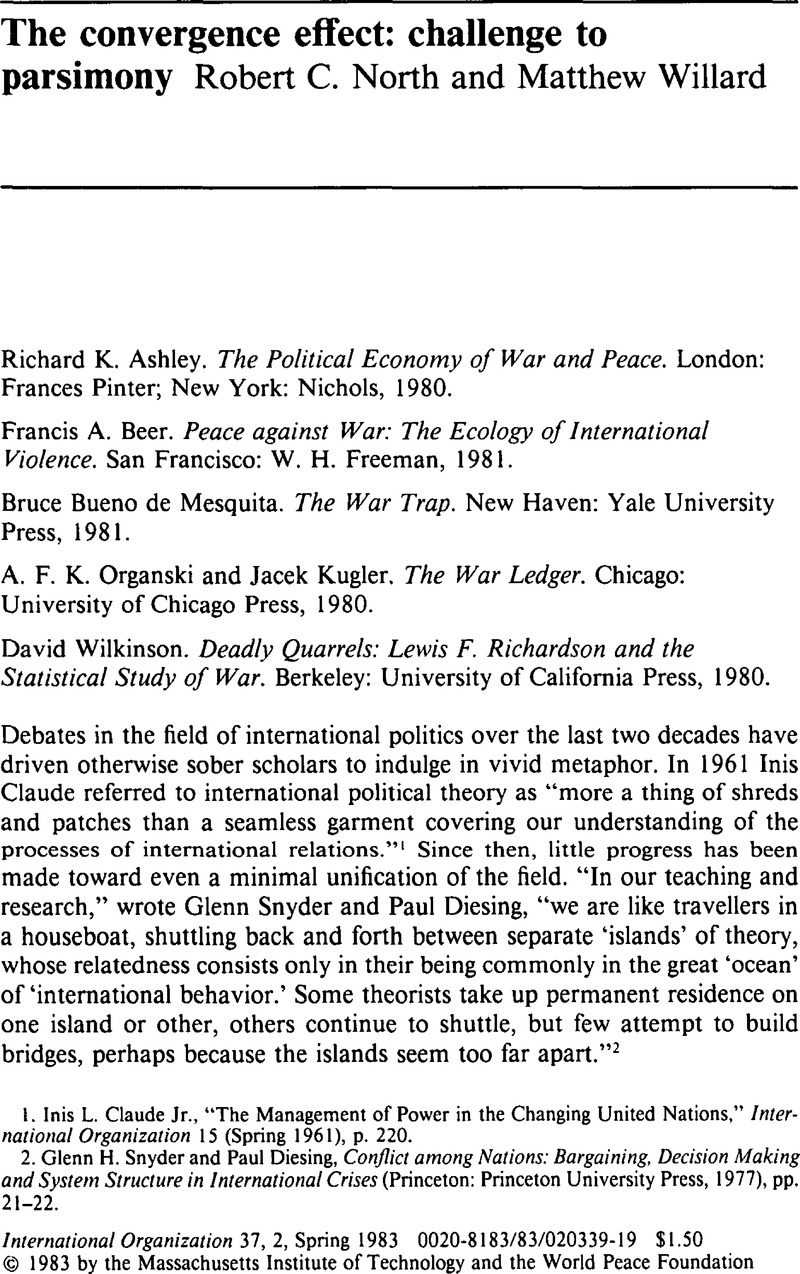Article contents
The convergence effect: challenge to parsimony
Review products
Published online by Cambridge University Press: 22 May 2009
Abstract

Information
- Type
- Review essay
- Information
- Copyright
- Copyright © The IO Foundation 1983
References
1. Claude, Inis L. Jr, “The Management of Power in the Changing United Nations,” International Organization 15 (Spring 1961), p. 220CrossRefGoogle Scholar.
2. Snyder, Glenn H. and Diesing, Paul, Conflict among Nations: Bargaining, Decision Making and System Structure in International Crises (Princeton: Princeton University Press, 1977), pp. 21–22Google Scholar.
3. Hopmann, P. Terrence, Zinnes, Dina A., and Singer, J. David, eds., Cumulation in International Relations Research, University of Denver Monograph Series in World Affairs 18 Book 3 (1981), pp. 30–31Google Scholar.
4. Waltz, Kenneth N., Man, the State and War: A Theoretical Analysis (New York: Columbia University Press, 1959), p. 12Google Scholar.
5. Eulau, Heinz, The Behavioral Persuasion in Politics (New York: Random House, 1963), p. 123Google Scholar.
6. Rosenau, James, Linkage Politics (New York: Free Press, 1969), pp. 44–45Google Scholar.
7. Hopmann, , Zinnes, , and Singer, , Cumulation, pp. 30–31Google Scholar.
8. Choucri, Nazli and North, Robert C., Nations in Conflict: National Growth and International Violence (San Francisco: W. H. Freeman, 1975)Google Scholar.
9. Compare Cyert, Richard M. and March, James G., A Behavioral Theory of the Firm (Englewood Cliffs, N.J.: Prentice-Hall, 1963), pp. 99–101Google Scholar.
10. Harold, and Sprout, Margaret, The Ecological Perspective on Human Affairs (Princeton: Princeton University Press, 1965), p. 11Google Scholar.
11. Simon, Herbert A., Administrative Behaviors (New York: Macmillan, 1955), pp. 3–6Google Scholar; von Neumann, John and Morgenstern, Oskar, Theory of Games and Economic Behavior (Princeton: Princeton University Press, 1947), p. 17Google Scholar.
12. Boulding, Kenneth E., The Image (Ann Arbor: University of Michigan Press, 1956), p. 11CrossRefGoogle Scholar; Deutsch, Karl W., The Nerves of Government (New York: Free Press, 1963), pp. 75–97Google Scholar.
13. Easton, David, A Systems Analysis of Political Life (New York: John Wiley, 1965), pp. 38–39Google Scholar.
14. Kuznets, Simon, Modern Economic Growth: Rate, Structure and Spread (New Haven: Yale University Press, 1955), pp. 334–48Google Scholar.
15. Lasswell, Harold D., Politics: Who Gets What, When and How (New York: Meridian, 1958)Google Scholar.
16. Schelling, Thomas C., The Strategy of Conflict (Cambridge: Harvard University Press, 1960), p. 5; 1Google Scholar. Zartman, William, The 50% Solution (Garden City, N.Y.: Doubleday Anchor, 1976)Google Scholar.
17. Riker, William, The Theory of Political Coalitions (New Haven: Yale University Press, 1962)Google Scholar; Snyder, and Diesing, , Conflict among Nations; and Iklé, Fred Charles, How Nations Negotiate (New York: Harper & Row, 1964)Google Scholar.
18. See Rapaport, Anatol, “A Probabilistic Approach to Networks,” Social Networks 2 (1979/1980): 1–18CrossRefGoogle Scholar; Modelski, George, Principles of World Politics (New York: Free Press, 1972), pp. 232, 270–72Google Scholar, refers to “layered networks.”
19. See Haas, Ernst B., “Words Can Hurt You; or, Who Said What to Whom about Regimes,” International Organization 36 (Spring 1982), p. 242CrossRefGoogle Scholar: “The existence of structure must be demonstrated…not prespecified.”
20. See, for example, Gilpin, Robert, War and Change in World Politics (New York: Cambridge University Press, 1981)CrossRefGoogle Scholar; Choucri and North, Nations in Conflict.
21. See Almond, Gabriel and Powell, G. Bingham Jr, System, Process and Policy: Comparative Politics (Boston: Little, Brown, 1978), chap. 2Google Scholar.
22. Richardson, Lewis F., Statistics of Deadly Quarrels (Pittsburgh: Boxwood Press, 1960)Google Scholar.
23. Richardson, Lewis F., Arms and Insecurity (Pittsburgh: Boxwood Press, 1960)Google Scholar.
24. Schelling, Thomas, Arms and Influence (New Haven: Yale University Press, 1955)Google Scholar; George, Alexander F., Hall, David K., and Simons, William R., The Limits of Coercive Diplomacy (Boston: Little, Brown, 1971)Google Scholar; George, Alexander and Smoke, Richard, Deterrence in American Foreign Policy: Theory and Practice (New York: Columbia University Press, 1974)Google Scholar; Young, Oran, The Politics of Force: Bargaining during International Crises (Princeton: Princeton University Press, 1968)Google Scholar; Snyder and Diesing, Conflict among Nations. Riker's application of the “size” principle to coalitional and adversarial bargaining is crucial to the notion of international conflict (in Theory of Political Coalitions).
25. Riker, , Theory of Political Coalitions, p. 12.Google Scholar; Snyder, and Diesing, , Conflict among Nations, p. 349Google Scholar; Cyert, and March, , Behavioral Theory, pp. 99, 124Google Scholar.
26. de Mesquita, Bruce Bueno, “Risk, Power Distributions, and the Likelihood of War,” International Studies Quaterly 25 (12 1981), p. 566Google Scholar.
27. Schelling, Strategy of Conflict.
28. As a revised edition of the book, now in progress, may demonstrate.
- 6
- Cited by

